The Influence of the Ratio of Nitrate to Ammonium Nitrogen on Nitrogen Removal in the Economical Growth of Vegetation in Hybrid Constructed Wetlands
Abstract
:1. Introduction
2. Materials and Methods
2.1. Experimental Site and Constructed Wetland
2.2. Experimental Conditions
2.3. Analytical Methods
2.4. Statistical Method
3. Results
3.1. NH4–N Removal under Different NO3–N/NH4–N Ratios
3.2. NO3–N Removal under Different NO3–N/NH4–N Ratios
3.3. Total Nitrogen Removal under Different NO3–N/NH4–N Ratios
4. Discussion
5. Conclusions
- Ipomoea aquatica Forsk. and Solanum melongena L. showed higher removal efficiency for NH4–N under higher ammonium concentrations, whereas Allium porrum L. showed higher NO3–N removal when NO3–N concentrations were high in wastewater. Compared to other vegetables Capsicum annuum L. showed little efficiency for both N sources.
- The different plants may differ in their capacity to take in N from different nitrogen sources and therefore should select plants economically so that a constructed wetland can obtain optimum removal of nutrients as well as optimum growth.
- The gap between supply and demand for water and food can be reduced using a constructed wetland for the economical growth of plants, and this approach can broaden the application of a constructed wetland.
Acknowledgments
Author Contributions
Conflicts of Interest
References
- Igbinosa, E.; Okoh, A. Impact of discharge wastewater effluents on the physico-chemical qualities of a receiving watershed in a typical rural community. Int. J. Environ. Sci. Technol. 2009, 6, 175–182. [Google Scholar] [CrossRef]
- Massoud, M.A.; Tarhini, A.; Nasr, J.A. Decentralized approaches to wastewater treatment and management: Applicability in developing countries. J. Environ. Manag. 2009, 90, 652–659. [Google Scholar] [CrossRef] [PubMed]
- Wilkoff, B.L.; Bello, D.; Taborsky, M.; Vymazal, J.; Kanal, E.; Heuer, H.; Hecking, K.; Johnson, W.B.; Young, W.; Ramza, B. Magnetic resonance imaging in patients with a pacemaker system designed for the magnetic resonance environment. Heart Rhythm 2011, 8, 65–73. [Google Scholar] [CrossRef] [PubMed] [Green Version]
- Xu, Q.; Chen, S.; Huang, Z.; Cui, L.; Wang, X. Evaluation of organic matter removal efficiency and microbial enzyme activity in vertical-flow constructed wetland systems. Environments 2016, 3, 26. [Google Scholar] [CrossRef]
- Abbasi, H.N.; Lu, X.; Xu, F.; Xie, J. Wastewater treatment strategies in china: An overview. Sci. Lett. 2016, 4, 15–25. [Google Scholar]
- Jing, S.-R.; Lin, Y.-F.; Lee, D.-Y.; Wang, T.-W. Nutrient removal from polluted river water by using constructed wetlands. Bioresour. Technol. 2001, 76, 131–135. [Google Scholar] [CrossRef]
- Kaseva, M. Performance of a sub-surface flow constructed wetland in polishing pre-treated wastewater—A tropical case study. Water Res. 2004, 38, 681–687. [Google Scholar] [CrossRef] [PubMed]
- Lee, C.-Y.; Lee, C.-C.; Lee, F.-Y.; Tseng, S.-K.; Liao, C.-J. Performance of subsurface flow constructed wetland taking pretreated swine effluent under heavy loads. Bioresour. Technol. 2004, 92, 173–179. [Google Scholar] [CrossRef] [PubMed]
- Wallace, S.; Kadlec, R. Btex degradation in a cold-climate wetland system. Water Sci. Technol. 2005, 51, 165–171. [Google Scholar] [PubMed]
- Maine, M.; Sune, N.; Hadad, H.; Sánchez, G. Temporal and spatial variation of phosphate distribution in the sediment of a free water surface constructed wetland. Sci. Total Environ. 2007, 380, 75–83. [Google Scholar] [CrossRef] [PubMed]
- Ahmed, S.; Popov, V.; Trevedi, R.C. Constructed wetland as tertiary treatment for municipal wastewater. In Proceedings of the Institution of Civil Engineers-Waste and Resource Management; Thomas Telford Ltd.: London, UK, 2008; pp. 77–84. [Google Scholar]
- Li, X.; Manman, C.; Anderson, B.C. Design and performance of a water quality treatment wetland in a public park in shanghai, china. Ecol. Eng. 2009, 35, 18–24. [Google Scholar] [CrossRef]
- Martín, M.; Oliver, N.; Hernández-Crespo, C.; Gargallo, S.; Regidor, M. The use of free water surface constructed wetland to treat the eutrophicated waters of lake l’albufera de valencia (Spain). Ecol. Eng. 2013, 50, 52–61. [Google Scholar] [CrossRef]
- Cordell, D.; Drangert, J.-O.; White, S. The story of phosphorus: Global food security and food for thought. Glob. Environ. Chang. 2009, 19, 292–305. [Google Scholar] [CrossRef]
- Qadir, M.; Sharma, B.R.; Bruggeman, A.; Choukr-Allah, R.; Karajeh, F. Non-conventional water resources and opportunities for water augmentation to achieve food security in water scarce countries. Agric. Water Manag. 2007, 87, 2–22. [Google Scholar] [CrossRef]
- Briones, A.M., Jr.; Okabe, S.; Umemiya, Y.; Ramsing, N.-B.; Reichardt, W.; Okuyama, H. Ammonia-oxidizing bacteria on root biofilms and their possible contribution to n use efficiency of different rice cultivars. Plant Soil 2003, 250, 335–348. [Google Scholar] [CrossRef]
- Vasileva, V.; Ilieva, A. Chemical composition, nitrate reductase activity and plastid pigments content in lucerne under the influence of ammonium and nitrate form mineral nitrogen. Agron. Res. 2011, 9, 357–364. [Google Scholar]
- Forde, B.G.; Clarkson, D.T. Nitrate and ammonium nutrition of plants: Physiological and molecular perspectives. Adv. Bot. Res. 1999, 30, 1–90. [Google Scholar]
- Rayar, A.J.; Van Hai, T. Effect of ammonium on uptake of phosphorus, potassium, calcium and magnesium by intact soybean plants. Plant Soil 1977, 48, 81–87. [Google Scholar] [CrossRef]
- Bindraban, P.S.; Dimkpa, C.; Nagarajan, L.; Roy, A.; Rabbinge, R. Revisiting fertilisers and fertilisation strategies for improved nutrient uptake by plants. Biol. Fertil. Soils 2015, 51, 897–911. [Google Scholar] [CrossRef]
- Serna, M.; Borras, R.; Legaz, F.; Primo-Millo, E. The influence of nitrogen concentration and ammonium/nitrate ratio on n-uptake, mineral composition and yield of citrus. Plant Soil 1992, 147, 13–23. [Google Scholar] [CrossRef]
- Ali, A.; Tucker, T.; Thompson, T.; Salim, M. Effects of salinity and mixed ammonium and nitrate nutrition on the growth and nitrogen utilization of barley. J. Agron. Crop Sci. 2001, 186, 223–228. [Google Scholar] [CrossRef]
- Guo, S.; Brück, H.; Sattelmacher, B. Effects of supplied nitrogen form on growth and water uptake of french bean (phaseolus vulgaris l.) plants. Plant Soil 2002, 239, 267–275. [Google Scholar] [CrossRef]
- Vojtíšková, L.; Munzarová, E.; Votrubová, O.; Řihová, A.; Juřicová, B. Growth and biomass allocation of sweet flag (acorus calamus l.) under different nutrient conditions. Hydrobiologia 2004, 518, 9–22. [Google Scholar] [CrossRef]
- Kotsiras, A.; Olympios, C.; Passam, H. Effects of nitrogen form and concentration on yield and quality of cucumbers grown on rockwool during spring and winter in southern greece. J. Plant Nutr. 2005, 28, 2027–2035. [Google Scholar] [CrossRef]
- Juan, L.; Zhou, J.-M.; Duan, Z.-Q. Effects of elevated CO2 concentration on growth and water usage of tomato seedlings under different ammonium/nitrate ratios. J. Environ. Sci. 2007, 19, 1100–1107. [Google Scholar]
- Rosen, C.J.; Allan, D.L.; Luby, J.J. Nitrogen form and solution ph influence growth and nutrition of two vaccinium clones. J. Am. Soc. Hortic. Sci. 1990, 115, 83–89. [Google Scholar]
- Below, F.E. Nitrogen metabolism and crop productivity. Handb. Plant Crop Physiol. 2002, 2, 385–406. [Google Scholar]
- Savvas, D.; Passam, H.; Olympios, C.; Nasi, E.; Moustaka, E.; Mantzos, N.; Barouchas, P. Effects of ammonium nitrogen on lettuce grown on pumice in a closed hydroponic system. HortScience 2006, 41, 1667–1673. [Google Scholar]
- Tylova-Munzarova, E.; Lorenzen, B.; Brix, H.; Votrubova, O. The effects of NH4+ and NO3− on growth, resource allocation and nitrogen uptake kinetics of phragmites australis and glyceria maxima. Aquat. Bot. 2005, 81, 326–342. [Google Scholar] [CrossRef]
- Zhai, Y.-M.; Hou, M.-M.; Shao, X.-H.; Yang, Q. The comprehensive effects of the subsurface drainage on greenhouse saline soil, tomato yield and quality. Adv. J. Food Sci. Technol. 2016, 10, 691–694. [Google Scholar]
- Zhang, Y.; Lin, X.; Zhang, Y.; Zheng, S.J.; Du, S. Effects of nitrogen levels and nitrate/ammonium ratios on oxalate concentrations of different forms in edible parts of spinach. J. Plant Nutr. 2005, 28, 2011–2025. [Google Scholar] [CrossRef]
- Federation, W.E.; Association, A.P.H. Standard Methods for the Examination of Water and Wastewater; American Public Health Association (APHA): Washington, DC, USA, 2005. [Google Scholar]
- Petrucio, M.; Esteves, F. Uptake rates of nitrogen and phosphorus in the water by eichhornia crassipes and salvinia auriculata. Revista Brasileira de Biologia 2000, 60, 229–236. [Google Scholar] [CrossRef] [PubMed]
- Santamaria, P.; Elia, A.; Parente, A.; Serio, F. Fertilization strategies for lowering nitrate content in leafy vegetables: Chicory and rocket salad cases. J. Plant Nutr. 1998, 21, 1791–1803. [Google Scholar] [CrossRef]
- Mengel, K.; Kirkby, E.A.; Kosegarten, H.; Appel, T. Nitrogen. In Principles of Plant Nutrition; Springer: Berlin, Germany, 2001; pp. 397–434. [Google Scholar]
- Zhang, F.C.; Kang, S.Z.; Li, F.S.; Zhang, J.H. Growth and major nutrient concentrations in brassica campestris supplied with different NH4+/NO3− ratios. J. Integr. Plant Biol. 2007, 49, 455–462. [Google Scholar] [CrossRef]
- Vymazal, J. Removal of nutrients in various types of constructed wetlands. Sci. Total Environ. 2007, 380, 48–65. [Google Scholar] [CrossRef] [PubMed]
- Lee, C.G.; Fletcher, T.D.; Sun, G. Nitrogen removal in constructed wetland systems. Eng. Life Sci. 2009, 9, 11–22. [Google Scholar] [CrossRef]
- Lv, T.; Zhang, Y.; Carvalho, P.N.; Zhang, L.; Button, M.; Arias, C.A.; Weber, K.P.; Brix, H. Microbial community metabolic function in constructed wetland mesocosms treating the pesticides imazalil and tebuconazole. Ecol. Eng. 2017, 98, 378–387. [Google Scholar] [CrossRef]
- Picot, B.; El Halouani, H.; Casellas, C.; Moersidik, S.; Bontoux, J. Nutrient removal by high rate pond system in a mediterranean climate (France). Water Sci. Technol. 1991, 23, 1535–1541. [Google Scholar]
- Singh, S.; Kaushik, A.; Kaushik, C. Comparing efficacy of down-flow and up-flow vertical constructed wetlands for treatment of simulated dumpsite leachate. Imp. J. Interdiscip. Res. 2016, 2, 942–945. [Google Scholar]
- Tang, X.; Huang, S.; Scholz, M. Nutrient removal in wetlands during intermittent artificial aeration. Environ. Eng. Sci. 2008, 25, 1279–1290. [Google Scholar] [CrossRef]
- Devaux, C.; Baldet, P.; Joubès, J.; Dieuaide-Noubhani, M.; Just, D.; Chevalier, C.; Raymond, P. Physiological, biochemical and molecular analysis of sugar-starvation responses in tomato roots. J. Exp. Bot. 2003, 54, 1143–1151. [Google Scholar] [CrossRef] [PubMed]
- Stottmeister, U.; Wießner, A.; Kuschk, P.; Kappelmeyer, U.; Kästner, M.; Bederski, O.; Müller, R.; Moormann, H. Effects of plants and microorganisms in constructed wetlands for wastewater treatment. Biotechnol. Adv. 2003, 22, 93–117. [Google Scholar] [CrossRef] [PubMed]
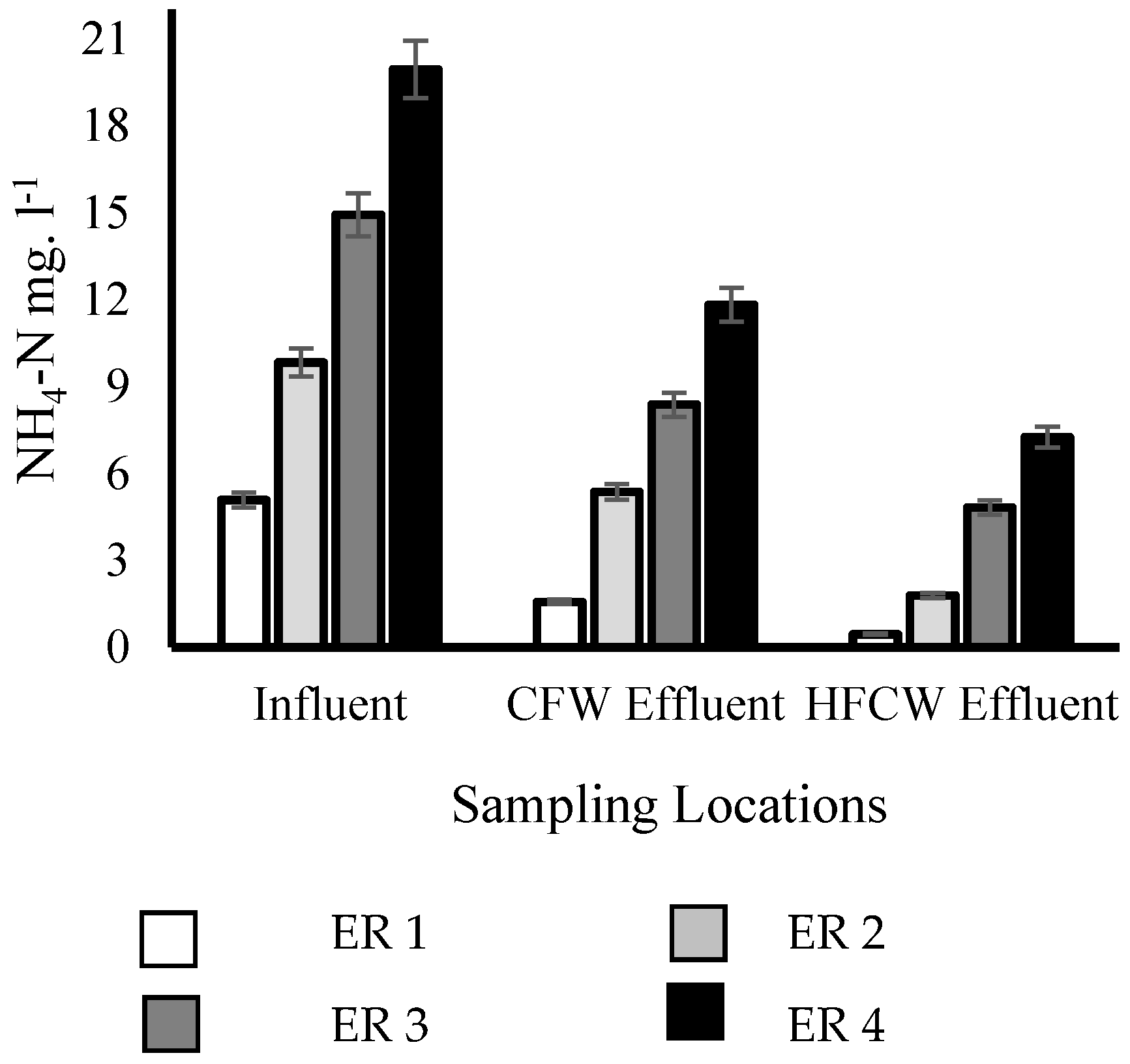
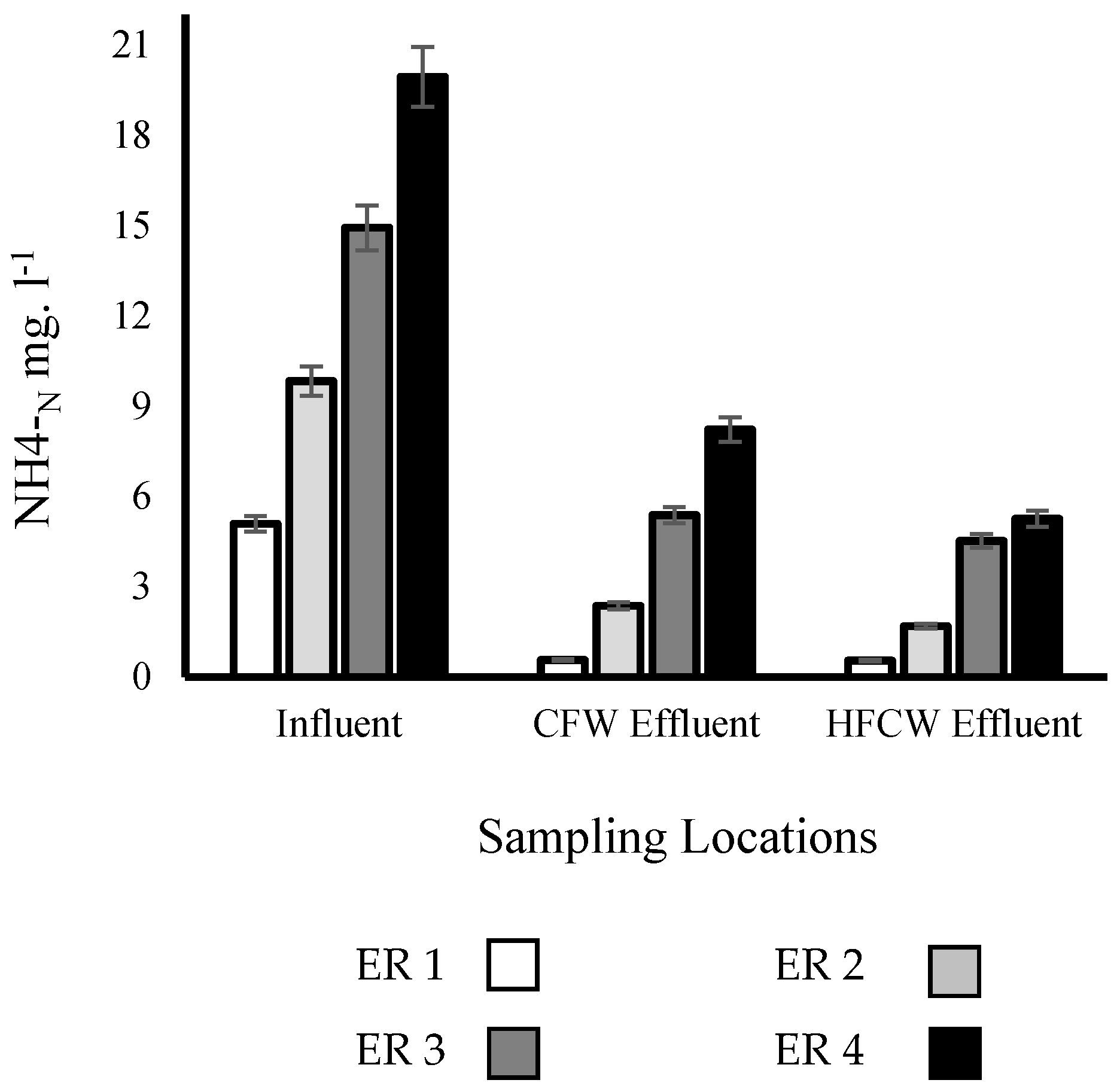
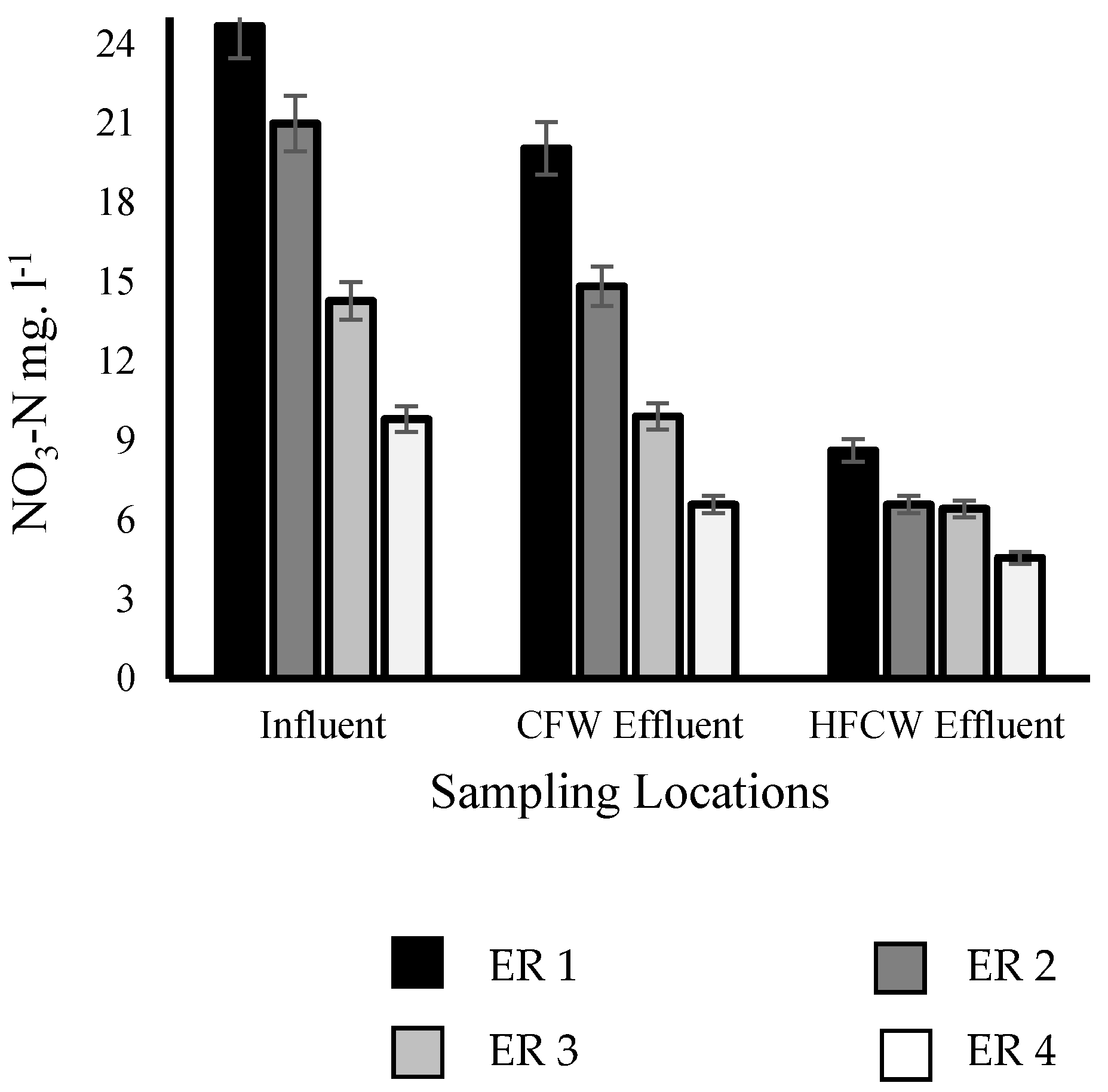
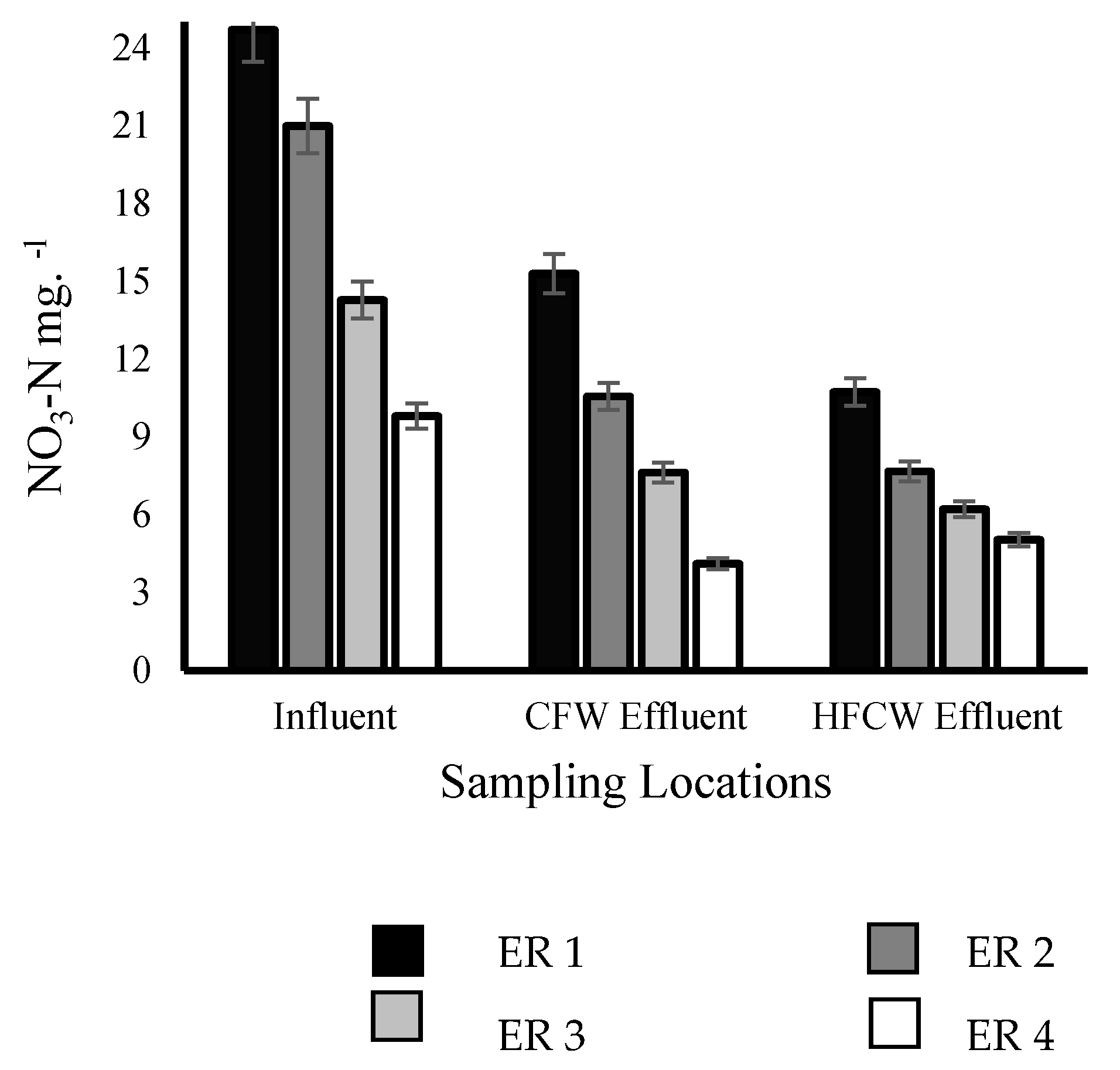
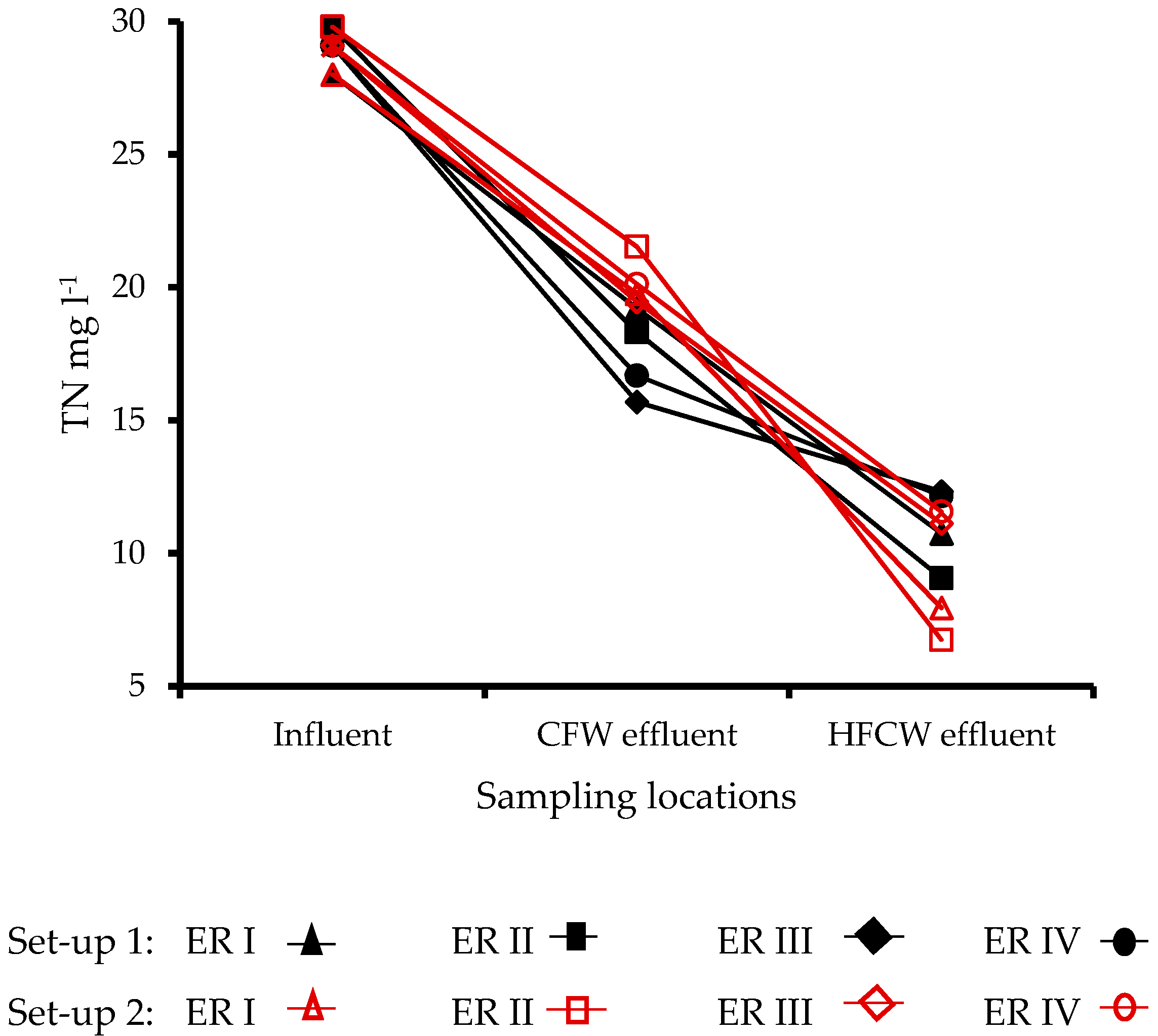
| Number | Common Name | Scientific Name | Used Name |
|---|---|---|---|
| 1 | Leek | Allium porrum L. | A. porrum |
| 2 | Egg Plant | Solanum melongena L. | S. melongena |
| 3 | Water spinach | Ipomoea aquatica Forsk. | I. aquatica |
| 4 | Hot pepper | Capsicum annuum L. | C. annuum L. |
| Experimental Run (ER) | NO3–N/NH4–N | NO3–N | NH4–N | TN | TP | COD |
|---|---|---|---|---|---|---|
| mg·L−1 | ||||||
| 1 | 5:1 | 24.69 | 5.08 | 29.51 | 3.05 | 89.14 |
| 2 | 2:1 | 20.99 | 9.83 | 29.41 | 2.92 | 91.25 |
| 3 | 1:1 | 14.28 | 14.93 | 30.10 | 2.86 | 88.63 |
| 4 | 1:2 | 9.90 | 19.94 | 29.83 | 2.91 | 90.93 |
| Set-up | Test | ER | Influent | CFW | HFCW | ||||||
|---|---|---|---|---|---|---|---|---|---|---|---|
| Min | Max | Mean ± SD ** | Min | Max | Mean ± SD ** | Min | Max | Mean ± SD ** | |||
| Mg·L−1 | |||||||||||
| 1 | NH4 | I | 4.20 | 5.90 | 5.061 ± 0.850 | 1.40 | 1.60 | 1.52 ± 0.106 | 0.40 | 0.05 | 0.442 ± 0.402 |
| II | 9.70 | 9.90 | 9.8104 ± 0.1016 | 5.00 | 5.60 | 5.322 ± 0.302 | 1.58 | 1.98 | 1.782 ± 0.200 | ||
| III | 14.60 | 15.20 | 14.909 ± 0.300 | 8.10 | 8.50 | 8.325 ± 0.205 | 4.71 | 4.91 | 4.8133 ± 0.1002 | ||
| IV | 19.89 | 19.99 | 19.941 ± 0.050 | 11.70 | 11.90 | 11.806 ± 0.101 | 7.22 | 7.28 | 7.2521 ± 0.0302 | ||
| NO3 | I | 24.40 | 24.80 | 24.630 ± 0.207 | 19.00 | 21.00 | 20.019 ± 1.001 | 8.42 | 8.82 | 8.622 ± 0.200 | |
| II | 20.80 | 21.20 | 20.997 ± 0.200 | 14.70 | 14.90 | 14.810 ± 0.101 | 6.47 | 6.67 | 6.5723 ± 0.1001 | ||
| III | 14.00 | 14.60 | 14.295 ± 0.300 | 9.86 | 9.96 | 9.9110 ± 0.0500 | 6.31 | 6.51 | 6.4112 ± 0.1000 | ||
| IV | 9.70 | 9.90 | 9.8036 ± 0.1002 | 6.37 | 6.77 | 6.571 ± 0.200 | 4.47 | 4.67 | 4.5703 ± 0.1000 | ||
| TN | I | 27.00 | 29.00 | 28.002 ± 1.000 | 19.10 | 19.30 | 19.202 ± 0.100 | 10.64 | 10.84 | 10.741 ± 0.100 | |
| II | 29.70 | 29.90 | 29.800 ± 0.100 | 18.10 | 18.50 | 18.304 ± 0.200 | 9.04 | 9.08 | 9.0623 ± 0.0204 | ||
| III | 29.05 | 29.15 | 29.100 ± 0.050 | 15.48 | 15.88 | 15.683 ± 0.200 | 12.10 | 12.52 | 12.315 ± 0.210 | ||
| IV | 28.00 | 30.00 | 29.033 ± 1.002 | 16.58 | 16.78 | 16.682 ± 0.100 | 11.00 | 13.20 | 12.118 ± 1.100 | ||
| 2 | NH4 | I | 4.20 | 5.90 | 5.061 ± 0.850 | 0.30 | 0.80 | 0.555 ± 0.250 | 0.34 | 0.74 | 0.543 - 0.200 |
| II | 9.70 | 9.83 | 9.8104 ± 0.1016 | 2.25 | 2.45 | 2.3553 ± 0.1004 | 1.40 | 1.80 | 1.629 ± 0.206 | ||
| III | 14.60 | 15.20 | 14.909 ± 0.300 | 5.07 | 5.67 | 5.372 ± 0.300 | 4.30 | 4.70 | 4.507 ± 0.200 | ||
| IV | 19.89 | 19.99 | 19.941 ± 0.050 | 8.10 | 8.30 | 8.2064 ± 0.1006 | 4.20 | 6.20 | 5.252 ± 1.000 | ||
| NO3 | I | 24.40 | 24.80 | 24.630 ± 0.207 | 14.29 | 16.29 | 15.293 ± 1.000 | 9.70 | 11.70 | 10.709 ± 1.000 | |
| II | 20.80 | 21.20 | 20.997 ± 0.200 | 9.56 | 11.56 | 10.561 ± 1.000 | 6.60 | 8.60 | 7.623 ± 1.001 | ||
| III | 14.00 | 14.60 | 14.295 ± 0.300 | 7.42 | 7.82 | 7.620 ± 0.200 | 6.00 | 6.41 | 6.209 ± 0.205 | ||
| IV | 9.70 | 9.90 | 9.8036 ± 0.1002 | 3.10 | 5.10 | 4.103 ± 1.000 | 4.70 | 5.30 | 5.013 ± 0.301 | ||
| TN | I | 27.00 | 29.00 | 28.002 ± 1.000 | 17.75 | 21.75 | 19.75 ± 2.00 | 7.95 | 8.64 | 8.276 ± 0.348 | |
| II | 29.70 | 29.90 | 29.800 ± 0.100 | 20.52 | 22.52 | 21.523 ± 1.000 | 6.48 | 7.00 | 6.743 ± 0.260 | ||
| III | 29.05 | 29.15 | 29.100 ± 0.050 | 17.45 | 21.45 | 19.45 ± 2.00 | 10.50 | 11.62 | 11.082 ± 0.561 | ||
| IV | 28.00 | 30.00 | 29.033 ± 1.002 | 18.12 | 22.12 | 20.12 ± 2.00 | 10.56 | 12.56 | 11.563 ± 1.000 | ||
© 2017 by the authors. Licensee MDPI, Basel, Switzerland. This article is an open access article distributed under the terms and conditions of the Creative Commons Attribution (CC BY) license ( http://creativecommons.org/licenses/by/4.0/).
Share and Cite
Abbasi, H.N.; Vasileva, V.; Lu, X. The Influence of the Ratio of Nitrate to Ammonium Nitrogen on Nitrogen Removal in the Economical Growth of Vegetation in Hybrid Constructed Wetlands. Environments 2017, 4, 24. https://doi.org/10.3390/environments4010024
Abbasi HN, Vasileva V, Lu X. The Influence of the Ratio of Nitrate to Ammonium Nitrogen on Nitrogen Removal in the Economical Growth of Vegetation in Hybrid Constructed Wetlands. Environments. 2017; 4(1):24. https://doi.org/10.3390/environments4010024
Chicago/Turabian StyleAbbasi, Haq Nawaz, Viliana Vasileva, and Xiwu Lu. 2017. "The Influence of the Ratio of Nitrate to Ammonium Nitrogen on Nitrogen Removal in the Economical Growth of Vegetation in Hybrid Constructed Wetlands" Environments 4, no. 1: 24. https://doi.org/10.3390/environments4010024





